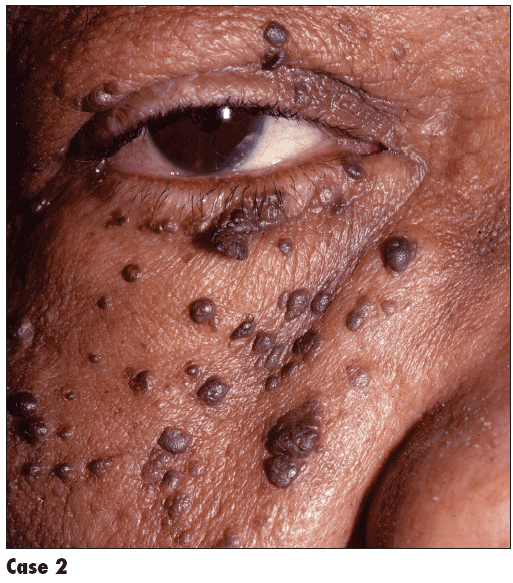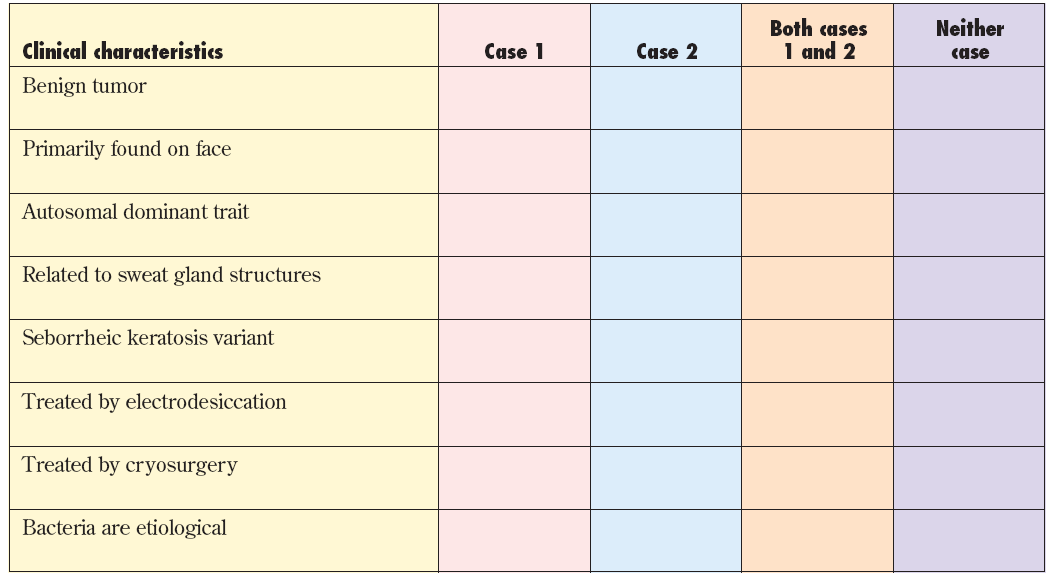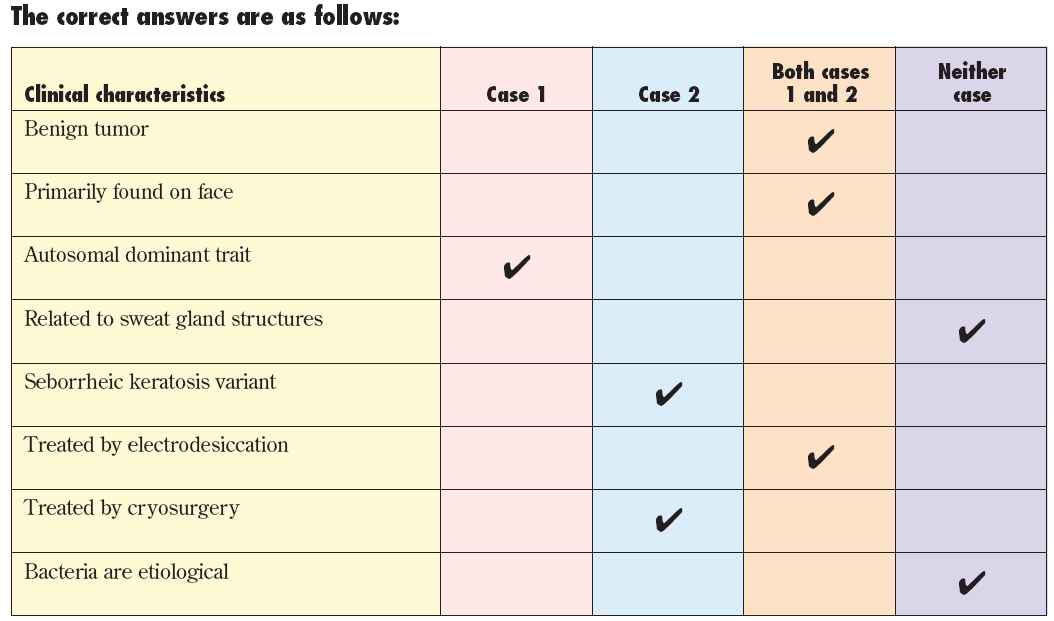Multiple Trichoepitheliomas and Dermatosis Papulosa Nigra
Match the following characteristics with the clinical disorders pictured in the photographs of Cases 1 and 2. Then read the brief descriptions that follow on the next page to see how well you did.
Match the following characteristics with the clinical disorders pictured in the photographs of Cases 1 and 2. Then read the brief descriptions that follow on the next page to see how well you did.




Discussion
Both of the disorders presented in Cases 1 and 2 typically have the face as the primary site of involvement, and both are benign tumors. Case 1 depicts multiple trichoepitheliomas, while Case 2 demonstrates a classic example of dermatosis papulosa nigra (DPN).
Case 1 is a 46-year-old woman whose skin lesions first developed 2 decades before presentation and have been increasing ever since that time. The multiple flat to slightly globoid, 2- to 8-mm skin-colored papules are entirely asymptomatic.

Trichoepithelioma represents a proliferation of elements which, according to histological features, diagnostic immunostaining, and ultrastructural analysis, are derived from the hair apparatus.1 When present in abundance, as in this case, trichoepithelioma is almost always an autosomal dominant inherited disease with specific mutations of tumor suppressor genes having been identified as etiological.2,3 Although the disorder is inherited equally, there is a preponderance of women in whom lesions actually develop, because of enhanced penetrance and expressivity compared with men. Trichoepitheliomas may be part of distinct multiple hamartoma syndromes, including the Brooke-Spiegler and Rombo syndromes. Rare variants include desmoplastic trichoepithelioma and giant trichoepithelioma.
Although these tumors have no long-term consequences, patients often desire removal for cosmetic reasons. Trichoepitheliomas can be destroyed with carbon dioxide laser ablation, dermabrasion or, most conveniently, electrodesiccation. 4,5 Take care to warn the patient, however, that recurrence is frequent and that cosmetically objectionable scarring may follow attempts at destruction.

Case 2 is a 58-year-old woman whose skin lesions have been developing only during the past 5 years. As is typical of DPN, several family members also have this problem, and it is fair to say that DPN is familial in nature. However, neither a specific inheritance pattern nor a specific genetic defect has been identified. This benign tumor occurs primarily in African Americans; indeed, DPN eventually develops in about 35% of all African Americans.6
DPN lesions are characteristically pigmented, may be pedunculate, and are often verrucous; they proliferate as patients age with neither a propensity toward malignant degeneration nor spontaneous involution.7 Histologically, DPN lesions closely resemble seborrheic keratoses but have been postulated to actually represent nevoid developmental defects in the pilosebaceous unit.8
Treatment of DPN is for cosmetic reasons and is accomplished by some form of ablation. Various lasers, liquid nitrogen cryosurgery, electrodesiccation, and simply snip excision with pressure hemostasis have all been employed successfully.9 As is true with trichoepitheliomas, the patient should be warned about recurrence and the potential for both scar formation and dyschromia following any type of ablative therapy.
References:
REFERENCES1. Brooke JD, Fitzpatrick JE, Golitz LE. Papillary mesenchymal bodies: a histologicfinding useful in differentiating trichoepitheliomas from basal cell carcinomas. J Am Acad Dermatol. 1989;21(3, pt 1):523-528.
2.Harada H, Hashimoto K, Ko MS. The gene for multiple familial trichoepithelioma maps to chromosome 9p21. J Invest Dermatol. 1996;107:41-43.
3. Bowen S, Gill M, Lee DA, et al. Mutations in the CYLD gene in Brooke-Spiegler syndrome, familial cylindromatosis, and multiple familial trichoepithelioma: lack ofgenotype-phenotype correlation. J Invest Dermatol. 2005;124:919-920.
4. Shaffelburg M, Miller R. Treatment of multiple trichoepithelioma with electrosurgery.Dermatol Surg. 1998;24:1154-1156.
5. Sajben FP, Ross EV. The use of the 1.0 mm handpiece in high energy, pulsedCO2 laser destruction of facial adnexal tumors. Dermatol Surg. 1999;25:41.
6. Dunwell P, Rose A. Study of the skin disease spectrum occurring in anAfro-Caribbean population. Int J Dermatol. 2003;42:287-289.
7. Rosen T, Martin S. Atlas of Black Dermatology. Boston: Little, Brown andCompany; 1981:100.
8. Hairston MA Jr, Reed RJ, Derbes VJ. Dermatosis papulosa nigra. Arch Dermatol.1964;89:655-658.
9. Kauh YC, McDonald JW, Rapaport JA, et al. A surgical approach for dermatosis papulosa nigra. Int J Dermatol. 1983;22:590-592.